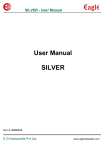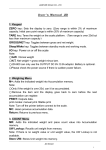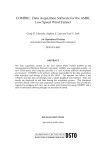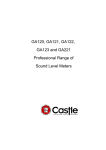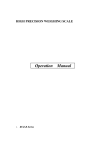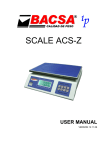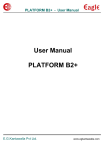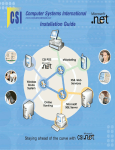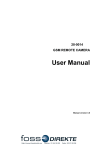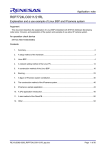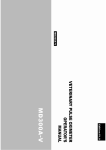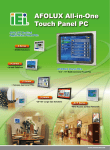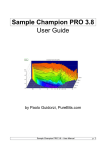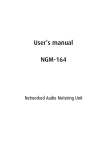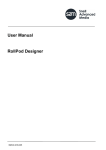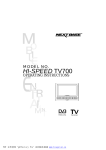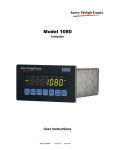Download SC-min/SC-1/SC-4 Indicator Manual Programming
Transcript
SC-min/SC-1/SC-4 Indicator Manual Programming SC-1 / SC-min LED Extendable advanced weighing machine with high luminosity and high contrast LED display SC-1 / SC-min LCD Extendable advanced weighing machine with backlit LCD display SC-4 / SC-4 LCD Desktop version of SC-1 indicator 2010-01-12 COMPLETE PROGRAMMING MANUAL ANALOGUE AND DIGITAL INDICATORS INDEX (Page) Keys 3 Quick Calibration 4 o Auto Calibration 4 Programming Menu 5 Extensions 23 o Multirrange o Linearisation 25 o SENSORED 27 Optional hardware parts o Via radio (SC1) PC Box 23 28 28 29 o 2nd Series 30 o Optocoupled serial channels 30 o Optocoupled RS-485 30 o Clock 31 o DSD (SC1) 31 o 4-20 mA and external inputs 31 o 0-10 V and external inputs 31 o 4-20mA, 3 relays, and external inputs (SC1) 32 o Relays and external inputs (SC1) 32 o Digital load cells (SC1) 33 o Ethernet 34 Digital Indicator (SC1) 39 PC Box 30 o Programming Menu 40 o Quick start up 43 o Last adjustments 43 o Digial load cell 44 o Cable connection 44 o Digital junction box 45 o Checking/Changing digital load cell number 45 o Electrical checking Public Scale - Purse (SCmin) o Purse Menu 46 47 47 PC Dump (SENSODATA) 49 Zebra Labeler 51 Litter counting (filling function) (SC1) 54 REMOTE-SC 56 LX-300 printer 59 Firmware updating 60 o Programming RS232 wire 60 o FlashMagic 60 Sensocar load cells ckecking 62 RS485 recommendations 63 Gravity Parameter and Formula 66 Circuit diagram 67 Quick instructions 68 -2- Keys Scroll 1 Scroll 2 ON/OFF Context Menu Navigating Scroll 3 T: Next Key Scroll 4 B: Previous Scroll 5 Scroll 6 6000 divisions metrologic range FUN: Leave Scroll 7 ENT: Enter/Save Description (standard functions) T Next option. B Previous option. FUN Leave or previous level. ENT Enter submenus. T Increase. If kept pressed, rapid increment will be done when scroll finishes. Entering B Decrease. If kept pressed, rapid decrement will be done when scroll finishes. data of 3 figures or less FUN Previous level. ENT Saves. T Increase digit. Entering B Change the digit to modify (indicated by the corresponding decimal point). data of over 3 figures FUN Previous level. ENT Saves. -3- QUICK CALIBRATION Enter Programming Menu (FUN+T during initial scroll) Auto Calibration I. Weight format (RANGE): ENT to enter, FUN to leave II. AUTO CALIBRATION (-AUTO-: ENT to enter, FUN to leave): a. Total capacity of load cells should be entered. b. Average ohms value offered to each load cell of sum junction box has to be set. System reset will be made after validating with ENT. Manual Calibration 1. Weight format (RANGE): ENT to enter, FUN to leave o Classic mode: Choose metrologic range o Manual mode:: o Set number of decimals (DECIM) Set weight fraction (-FRAC-) Set span range (-SPAN-) EXAMPLE: Scale of MAX=15kg at 3000 divisions (assuming compatible load cell set): 15000 g = 5g 3000div Weight fraction calculation: DECIM: 3 -FRAC-: 0.005 -SPAN-: 15.000 2. CALIBRATION ZERO (-ZERO-: ENT to execute) o Make platform zero calibration without weight (only with dead weight) 3. WEIGHT CALIBRATION (ADJUST: ENT to enter, FUN to leave) o Known weight should be put at platform (recommended near MAX/2) o Adjust as desired (ENT to save, FUN to leave): NORMAL: Normal mode weight visualization is done. To turn displayed weight to the known: • Increment (6) or decrement (4) • Quick Increment (8) or quick decrement (2) MANUAL: Last detected weight is displayed: • o Known weight can be directly set. High resolution adjustment may be done (ENT to save, FUN to leave): FINE: High resolution weight visualization is done (x10). To turn displayed weight to the known: • Increment (6) or decrement (4) • Quick Increment (8) or quick decrement (2) 4. LEAVE PROGRAMMING MENU (FUN as many times as needed) -4- PROGRAMMING MENU To enter, press FUN+T during the initial scroll. To leave, press FUN from the first menu level. The options and/or add-ons are shaded. Option ¾ RANGE ¾ ¾ ¾ ¾ ¾ ¾ ¾ ¾ ¾ ¾ ¾ ¾ ¾ ¾ ¾ ¾ ¾ ¾ ¾ ¾ ¾ ¾ ¾ ¾ ¾ ¾ ¾ ¾ ¾ ¾ Description - Choice of the range parameters METRO.R - Metrological ranges 3,000 6,000 6,000 15,000 15,000 30,000 30,000 60,000 60,000 150,00 150,00 300.0 300,00 600.0 600.0 1500.0 1500.0 3000 3000.0 6000 6000 15000 15000 30000 30000 60000 60000 150000 150000 1 g. 2 g. 1 g. 5 g. 2 g. 10 g. 5 g. 20 g. 10 g. 50 g. 20 g. 1 kg. 50 g. 0.2 kg. 0.1 kg. 0.5 kg. 0.2 kg. 1 kg. 0.5 kg. 2 kg. 1 kg. 5 kg. 2 kg. 10 kg. 5 kg. 20 kg. 10 kg. 50 kg. 20 kg. Actions ENT to enter a submenu and save. FUN to cancel and leave. ENT to save. T/B to change option. ENT to save. Before showing each full scale, the number of divisions corresponding to each of them will be indicated with M symbol (6000 when set, 3000 otherwise). NOTE: When entering the option, the metrological scales will be shown in increasing order, always from the first option. - -5- ¾ -SPAN- (value) Range span ¾ -FRAC- ¾ ¾ -ZERO- DECIM. (value) Step resolution (weight fraction) (value) Number of decimals - Indicator calibration zero - Adjusts the indicator gain ¾ ADJUST ¾ ¾ ¾ ¾ -AUTO- NORMAL (weight) Normal adjustment (as many divisions as scale divisions) FINE (weight) Fine adjustment (as many divisions as 10 times the scale divisions) MANUAL (value) Fine manual adjustment - Analog load cell autocalibration ¾ OTHERP - Indicator parameters ¾ STAB.T. ¾ UNSTA.T. (value) Unstability time ¾ STA.WIN. (value) Stability window ¾ FILTER (value) Stability time (value) Anti-oscillation filter (6 decimal digits). NOTE: Determines zero monitoring. (0..255 fractions). (0..3 decimals). ENT to save the zero in the equipment. ENT to enter a submenu. Within the submenu: T/B to increase/decrease slowly. T/B kept pressed during scroll to increase/decrease quickly. FUN to cancel and leave. ENT to save. NOTE: Modifies the gain (GA.CONV), and consequently the fraction points (PFr) of FIL.DEP. and the maximum zero absorption of ZEROAB. - (6 decimal digits). Set total load cell set capacity (in kg). When validated with ENT, -CORR- will be displayed for a while, and correction, if exists, might be set: Set average resistance of each potentiometer (in ohm tenths). If no resistance should be taken in account, default 0.0 may be validated. When validated with ENT, ZERO will be automatically done, GAIN calculation, and indicator RESET finally will be made in order to begin to weight. NOTE: The more capacity the more accuracy is achieved.NOTE: The more capacity the more accuracy is achieved. ENT to enter a submenu. FUN to leave the submenu. T/B to navigate via submenus. (0..255 fractions of second, approx. 0.5s). ENT to save. Recommended in accordance with the type of cell: -Analogue: 1..12 -Digital: 12..32 NOTE: The greater this is, the greater the precision in the weighing, although at reduced speed. (0..255 fractions of second, approx. 0.5s). ENT to save. Recommended to be the same as STAB.T. (0..255 fractions). ENT to save. If 0, 1/3 fraction will be applied. (0..255 samples per average within stability window). ENT to save. Recommended: 1..12 -6- ¾ FIL.DEP. (value) Internal converter filter ¾ GRAVI.P. (valor) Gravity Parameter ¾ ZEROIN Yes/No Initial zero ¾ 0-MEMO ¾ (LED) LIG.DIS. Yes/No Save manual zero to calibration zero (value) Display intensity ¾ ZEROAB (value) Zero absorption ¾ NOCER.F ¾ WEI.MIN. Yes/No Disables zero filterings (value) Minimum weighing. ¾ DEFAUL Yes/No Returns the indicator to its defect values ¾ VERSIO ¾ SERIAL ¾ MV.CELL ¾ METROL (value) Shows the firmware version - Production serial number (value) Shows load cell mV approximation Yes/No Metrologic parameters ¾ TARE.AC Yes/No Tare activation (0..255 internal points). ENT to save. When entering, a message which indicates the weighing Fraction Points is displayed. Example: P.Fr.=20 and we wish for action in 3 factions, then: VEN.FIL=20*3=60 NOTE: The greater this is, the greater the precision in the weighing, although at reduced speed. (6 decimal digits: Gravity acceleration in m/s2) ENT to save. Should be modified depending on Latitude and Altitude found in normalized tables. -P.1-: Local gravity parameter (By default: Barcelona). -P.2-: Destination gravity parameter. NOTE (h=height, y=latitude): g = 9,80612 - 2,5865*10-2cos2y + 5,8*10-5cos^2(2y) - 3,08*10-6h T/B to change option. ENT to save. T/B to change option. ENT to save. (1..7 values). FUN leaves. ENT saves. (0..25.5 divisions). ENT save. Depends on gain. When entering, maximum value we can achieve is displayed. T/B to change option. ENT to save. (0..25.5 divisions). ENT save. T/B to change option. ENT to save. When returning to defect values, “INI.EEP” will appear whilst the system restarts. When activating: - Dashes will be displayed whenever the gross weight is negative. - Upper or lower dashes will be displayed at start-up if the initial zero is 8% higher or lower than the calibration zero. - There will be no zero monitoring, nor can we carry out a manual zero, if the equipment zero has exceeded the full scale by 2%. ENT to change option. F to save. T/B to change option. ENT to save. -7- ¾ ZER.NEG ¾ REMOTE ¾ -PWD- ¾ DIS.OFF. ¾ (LCD) BACKLI ¾ ¾ ¾ ¾ ¾ ¾ ¾ ¾ (LCD) (LCD) (LCD) (LCD) (LCD) (LCD) (LCD) AUT.OFF ¾ ¾ ¾ ¾ ¾ ¾ Yes/No Auto zero is made when negative stability is detected Yes/No Remote access with REMOTE-SC (value) Entry password configuration Yes/No Do not show anything when weighing - Backlighting -ON-OFF1 MIN 5 MIN 15 MIN 30 MIN 60 MIN - -OFF1 MIN 5 MIN 15 MIN 30 MIN 60 MIN - ¾ CALIBR ¾ ZE.CON (value) ¾ GA.CON (value) T/B to change option. ENT to save. T/B to change option. ENT to save. (6 decimal digits). If “0”, password will be disabled. For PLC and repeating applications, when there are another displays. T/B to change option. ENT to save. The auto turn off backlighting time counter remains until another weighing takes place or another key is pressed. Otherwise it is fed back. Enabled Disabled 1 Minute 5 minutes 15 minutes 30 minutes 60 minutes Auto power off of the T/B to change option. equipment ENT to save. The auto power off time counter remains until another weighing takes place or another key is pressed. Otherwise it is fed back. Disabled 1 Minute 5 minutes 15 minutes 30 minutes 60 minutes Parametric calibration ENT to enter a submenu. values FUN to leave the submenu. T/B to navigate via submenus. Converter zero (6 hexadecimal digits). ENT to save. Useful to not have to re-calibrate the indicator when is changed. NOTE: See keys section enter characters A to F. Converter gain (As Ce.CON) -8- ¾ M.RANGE ¾ ¾ --ON-METRO.R. ¾ ¾ -SAPN- ¾ -FRAC- ¾ DECIM. ¾ LINEAR ¾ ¾ --ON-POINT ¾ POINT.M. ¾ MANUAL ¾ ¾ ERASE P.-1 ¾ ¾ … P.- 16 - Multirrange (works as ENT to enter a submenu. bi-scale) FUN to leave the submenu. ENT to save. NOTE: Indicates multirange error whenever we try to save incompatible data (see its section at this Manual). In this case, the option is automatically disabled. T/B to change option. Yes/No Enables the option T/B to change option. - Metrological ranges ENT to save. 3,000 1 g. (See option RANGE – METRO.R: from ranges 1 to 29) … … (6 decimal digits). (value) First span range NOTE: Determines multi-range zero monitoring. (value) Step resolution (weight fraction) of (0..255 fractions). the first range (value) Number of decimals (0..3 decimals). of the first range ENT to enter a submenu. - Linearisation FUN to leave the submenu. ENT to save. NOTE: Indicates linearisation error whenever we try to save a weight in excess of the full-scale (see its section in this Manual). In this case, the action is not saved. T/B to change option. Yes/No Enables the option T/B to increase/decrease slowly. (weight) Adjustment of the corrected weight point T/B kept pressed during scroll to increase/decrease quickly. on the platform FUN to cancel and leave. ENT to save. (weight) Manual adjustment of the corrected weight (6 decimal digits). point on the platform (weight) Manual adjustment of Used whenever we do not physically have the weight although we know the real weight and there is a non-linearity. the corrected weight –REAL- will be displayed, allowing us to enter the real weight: (6 decimal digits). When saving, –CORR- will be displayed in order to enter the corrected weight: (6 decimal digits). T/B to change option. Yes/No Delete all points Shows the real weight and corrected weight of the point. (values) Point value If the point does not exist, EMPTY is displayed. 3-second ENT pressing deletes. “ … … “ (values) Point value -9- ¾ RS-232 ¾ ¾ ¾ ¾ ¾ ¾ ¾ ¾ ¾ ¾ ¾ ¾ ¾ ¾ ¾ ¾ ¾ ¾ ¾ ¾ ¾ ¾ ¾ ¾ ¾ ¾ ¾ ¾ - Serial communication ENT to enter a submenu. parameters FUN to cancel and leave. T/B to navigate via submenus. ENT to save. T/B to change option. BAUDS - Speed 1200-B 1200 bauds 2400-B 2400 bauds 4800-B 4800 bauds 9600-B 9600 bauds 19200-B 19200 bauds T/B to change option. FRAME - Parity configuration NOTE: If the receiver equipment does not support 1 stop bit, 2 stop bits will be recognized. -N81- 8 bits with no parity -E71- 7 bits with even parity -O71- 7 bits with odd parity (0..99 assignable addresses). NUMBER (value) Equipment number LOOP - Cross test TX-RX ENT to test. UART-.1 Channel 1 ENT to test. UART-.2 Channel 2 T/B to change option. CONNEC - Connect to… -PRIN- Printer -PC- PC T/B to change option. PRINTR. - Type of printer -STD- Standard EPC.1K EPC1100 (Fenix) CUSTOM TG558 (Custom) PAN-10 Panel 10 (Fenix) ZEBRA Zebra Labeler (Will enable LABEL and User Menu’s N.LABEL) TM-295 TM-295 (Epson) (And compatibles) GERMANPC (Parametric PC data dump) CUSTO2PlusII-S2B(Custom) (00h..FFh). LABEL - Label mask NOTA: See its section in this Manual. T/B to change option. PROTOC - Protocol ENT to save. NOTE: Protocols subject to customisable modifications. - 10 - ¾ SENSOC. Sensocar N82, continuous and by request. By defect, the gross weight is sent continuously. If the equipment is in a network of viewers, a viewer number different to 0 should be assigned. Num.Visor 0 xy Sign+weight(7)+CR Response: Response: xy+:+SP+Sig+weight(7)+C R Undercase response (flags): (xy+:+SP)+F1+weight(7)+ F1(bits): neg|bat|est|zer|net|T|B|M +CR xy+:+SP+level(8)+CR Response to battery level: Level =“NOB” (no battery) Level =”OK”,”LOW” (1 bit) Level=xxx (1 byte) Activation by Generic S+P+CR request commands: Net Weight S+N+CR +flags S+n+CR Gross weight S+B+CR +flags S+b+CR DIG: pts. cél. xx S+g+xx+CR DIG: neto cél. xx S+G+xx+CR Continuous S+F+CR Stable mode S+E+CR Zero S+C+CR Tare S+T+CR Untare S+D+CR Battery level S+L+CR Acknowledge S+A+CR Serial number S+S+CR Program version S+V+CR Intro/Print S+I+CR Shrinked weight S+M+CR DSD registring S+W+CR Relay read S+U+CR C1 Set relay action: S+Y+mask(C1..C8)+CR “0”: Active “1”: Inactive S+xy+genericletter+CR Directionable commands (Bytes) 9 13 9/13 13 3 3 3 3 3 5 5 3 3 3 3 3 3 3 3 3 3 3 3 3 4 5 CR: Carriage Return (0Dh) SP: Space (20h) C8..C1: 8 relay masks (up to 64 relays). C1 is current. - 11 - ¾ -1TOLEDO - E72, continuous mode. Response: ¾ -2GRAVIT. - (Bytes) 18 STX+A+B+C+weight(6)+Tare(6)+CR+CS A=x01x xnnn (n=ndec+2) B=xx11 INSTAB OVER NEG NET C=xxxx xxxx (SP) STX: Start of Text (02h) CR: Carriage Return (0Dh) CS: Checksum (negated XOR) 9600 N82, continuous and by request. (Bytes) Continuous response: Sign+weight(5)+mode+0+neg+zero+ tare+btare+gross+01,99+CR+LF @+weight(7)+CR Response request: @+?+CR Unrecognised request: Gross Commands GROSS+CR weight : Net NET+CR Weight ¾ -3PG - -4EXA - 9 3 6 5 Sign: If positive, send space. Neg: 1 if negative. 0 in other cases. Cero (Zero: 1 if zero. 0 in other cases. Tare: 1 if tare. 0 in other cases. Btare: 1 if tare lock. 0 in other cases. Gross: 1 if gross. 0 in other cases. CR: Carriage Return (0Dh) LF: Line Feed (0Ah) 9600 N82. Pressing FUN sends: Sign+grossweight(7)+Sign+netweight(7)+SP+Num(2)+CR ¾ 20 (Bytes) 20 Num: Viewer number SP: Space (20h) CR: Carriage Return (0Dh) N82, continuous and by request. Response: STX+flags+SP(3)+weight(5)+CR+LF $+CR Command Weight (Bytes) 12 2 Flags: “A” (stable), “!” (unstable), “I” (zero) STX: Start of Text (02h) SP: Space (20h) CR: Carriage Return (0Dh) LF: Line Feed (0Ah) $: Dolllar (24h) - 12 - ¾ -5PG2 - 9600 N82, continuous, stable and by request. Continuous: Response: B+grossweight(7)+ T+tareweight(7)+ N+ weight(7)+ A+ SP(3)+ accweight(7)+ P+ SP+ points(7)+ CR (Bytes) 45 Stable/Request (with ENT accumulates and sends): N.Indicator 0: xy: (Bytes) P+ #weighings(7)+ B+ grossweight(7)+ T+tareweight(7)+ N+ weight(7)+ A+ SP(3)+ accweight (7)+ C+ SP+ code(7)+ CR xy+:+SP+ P+ #weighings(7)+ B+ grossweight(7)+ T+tareweight(7)+ N+ weight(7)+ A+ SP(3)+ accweight (7)+ C+ SP+ code(7)+ CR 53 57 Option B: Response: C+0(6)+*+0(6)+*+0(5)+1*grossweight(7)+*+ tareweight(7)+*+weight(7)+0(2)+CR (Bytes) 48 Option C: Response: FR”PTX”+CR+LF+?+CR+LF+grossweight(7) + CR+LF+tareweight(7)+CR+LF+weight(7)+CR + LF+P1+CR+LF (Bytes) 43 Option D: Response: STX+SP(2)+weight(7)+CR+LF (Bytes) 12 tarehex(3)+hexweight(3)+00h(6)+CS (Bytes) 13 =+peso(6)+(2) (Bytes) 9 Option E: Response: Option F: Response: STX: Start of Text (02h) SP: Space (20h) CR: Carriage Return (0Dh) LF: Line Feed (0Ah) CS: Checksum (sum of bytes) - 13 - ¾ -6METLER - E72, continuous, stable and manual (when pressing ENT). (Bytes) Response STX+SP+sign+Weight(5)+SP+kg+CR+L F (no tare): Response STX+ SP(2)+ sign+ Weight(5)+ SP+ kg+ SP+ NET+ CR+ LF (tare): ¾ -7METSCH - 13 18 Sign: If positive it is SP. “-“ if not. STX: Start of Text (02h) SP: Space (20h) CR: Carriage Return (0Dh) LF: Line Feed (0Ah) E72, continuous mode. (Bytes) Response:STX+SP(4)+weight(5)+SP(5)+tareweight(4)+SP+A+ CR 22 A: “3” if stable; “1” if not. STX: Start of Text (02h) SP: Space (20h) CR: Carriage Return (0Dh) NOTE: tare weight still not implemented. ¾ -8- IE21.2 1200 O72 (Bytes) Com: Response: STX+VIS+weight(4)+FLG+SCAR+ +0+0+FRAC+NCER+ETX Weight STX+VIS+ENQ+ETX 13 4 ENQ: Enquiry (05h) VIS: Indicator number in ASCII WEIGHT: In fractions multiplied by 3, from LSB to MSB. FLG: “1” stable,”0” otherwise. (+8 if negative) SCAR: “1” overload, “0” otherwise. NCER: Number of ceros in ASCII. ¾ -9- IE21.5 E72 (Bytes) Response: S+FLG+SP+FLG2+SP+SP+SP+weight(6)+ +SP+”kg”+SP+CR+LF 19 FLG: “D” unstable, SP otherwise. FLG2: “-” negative, SP otherwise. WEIGHT: Without decimal point. - 14 - ¾ ¾ -10- IMARCH -11- MOBBA N82 Com: O72 Response: Weight Respuesta: Peso Comando: ¾ -12- IE150 -13- CYB20 ¾ -16- EPEL80 (Bytes) 7 33 17 CRCasci(2)i: Sum of the preceding. N81 (Bytes) Weight Broadca. STX+flg+weight(8)+CHKascii(2)+ +ETX 80h+numid(00h..1Fh) "$" 13 2 1 Weight(8) and flg as -4CHKascii(2): STX XOR flg XOR weight(8) XOR 0Ah FLG: “?” unstable, otherwise: “-“ negative “+” otherwise. E81 Com: ¾ weight(5)+flags+CR (Bytes) Com: -15- EPEL.A (Bytes) 10 3 Response: ":01040C0303”+net(6)+”0000000000 00”+CRCascii(2)+CR+LF Weight “:010400d2000623”+CR+LF Response: ¾ STX+FLG+weight(7)+ETX STX+ENQ+ETX Weight(5): If negative=> “;;)))0”, if overload=> “55???0”, no significative zeroes: "?" Flags: 0+0+1+1+tare+est+weimin+zero N82 Com: -14- EXA.R (Bytes) 9 1 FLG: “?” unstable, otherwise: “-“ negative “+” otherwise. 1200 N81 Response: ¾ STX+weight(7)+CR W Response: Weight STX+flags+weight(8)+CR $ (Bytes) 11 1 Response: Zero: Negative: Weight weight(7)+CR “0000000”+CR “AAAAAAA”+CR $ (Bytes) 8 8 8 1 (As -4-) N81 Com: - 15 - ¾ ¾ ¾ -17- EPEL.AN -18- CAMP.A -19- S-100 N82. No decimal point is sent. Com: N82 -20- S-400 STX+flags+weight(8)+CR+LF $ Response: tarehex(3)+weighthex(3)+00h(6)+ +CRC -21- GRAVI.2 Cont: Response: Weight STX+weight(6)+”0”+ETX STX+weight(6)+”0”+STA+ETX ENQ (05h) -22- ARPEGE (Bytes) 9 10 1 Weight(6): Reverse sending. STA: “e”stable and no ZERO, “0” otherwise N82 STX+weight(7)+ETX+CR (Bytes) 10 Gross(6)+.+CR+”:>” EST+0+CER+00010+CR+”:>” B+R+U+T+O+CR L+E+D+S+CR (Bytes) 10 11 6 5 Ex.: "123.456" Ex.: "123456." N82. No decimal point is sent. (ASCII) Com: ¾ 13 CRC: Sum of the preceding. N82 Response: ¾ (Bytes) 12 1 (Bytes) Com: ¾ Response: Weight Gross: Leds: Gross leds N82. No decimal point is sent. (Bytes) Response: Com: Sig: +/- ¾ -23- MAREC Weight W+sig+net(5)+sig+gross(5)+ STATUSascii(2)+CHKascii(2)+CR G+W+CR 18 3 STATUS: b.6 NET, b.4 EST, b.3 CER CHK: ADD+CPL N82. No decimal point is sent. (Bytes) Response: Com: Weight W+sig+net(5)+sig+gross(5)+ STATUSascii(2)+CHKascii(2)+CR G+W+CR 18 3 Sig: +/STATUS: b.6 NET, b.4 EST, b.3 CER CHK: ADD+CPL - 16 - ¾ ¾ ¾ -24- -S-25- SPIDER -26- EV.2001 N82. Sensocar natique protocol compatibilization. (As SENSOC, but 8/10 Bytes sending as decimal point) Continuous and stable Cont.: S+SP+sta+SP(3)+net(7)+SP(2)+”kg”+CR+LF G+SP(9)+net(7)+SP+”kg”+CRLF(2*4) Stable: sta: "S":Stable, "D":Unstable, "+":Overload 4800 E71 (Bytes) Response: ¾ -27- APOST Bruto Com: SP: Space Sig: SP/CR: Carriage Return (0Dh) LF: Line Feed (0Ah) 9600 O81 SP+SIG+net(7)+SP+kg+SP+B+ +CR+LF X+B+CR -28- PG3 Sign+net(7)+Sign+tare(7)+SP+Num(2)+CR ¾ -29- DLT-30 16 3 (Bytes) #+CDA+data(5)+CR+status+ +CR+XOR(2)+LF Generic #+SP+CDR+LF Com: CDR=10H, 12H, 16H, 18H, 1AH, 1CH, 14H, 20H Status (LSN): ERR+NEG+CER+EST CDA=CDR+1 SP: Space CR: Carriage Return (0Dh) LF: Line Feed (0Ah) 9600 O71. When FUN is pressed: Response: ¾ (Bytes) 19 28 12 4 (Bytes) 20 Num: Indicator number SP: Space (20h) CR: Carriage Return (0Dh) N82, continuous and manual. (Bytes) Response: (3 times) Weight Comm: STX: Sart of Text (02h) ETX: End of Text (03h) CR: Carriage Return (0Dh) STX+weight(7)+ETX+CR 10 $+CR 2 - 17 - ¾ -30- TF-1k ¾ -31- DAT.400 N82, manual (labeler) Response: Continuous sending: Net Comm and Ack: STX: Sart of Text (02h) ETX: End of Text (03h) ENQ: Enquiry (05h) ACK: Acknowledge (06h) CR: Carriage Return (0Dh) N82, continuous STX+net(6)+CR+ETX ENQ (Bytes) 9 1 ACK 1 (Bytes) STX+sta+w(6)+g(6)+p(6)+ETX+ 24 +CRC(2)+EOT Sta: “S”=>EST; “O”=>OVERL; E=>ERROR; M=>Motion STX: Sart of Text (02h) ETX: End of Text (03h) EOT: End of Transmision (04h) CR: Carriage Return (0Dh) T/B to change option. ENT to save. (The chain is sent continuously) (The chain is sent when obtaining the weight stability) (The chain is sent by request, or by pressing ENT) (1..25 dispatches per second). NOTE: This parameter will only take effect when the –SEND- option is set as continuous. Response: ¾ -SEND- ¾ ¾ ¾ ¾ S-SEC ¾ LINES ¾ ¾ ¾ ¾ ¾ PRI.DEC RS-485 - PC sending mode -CON-EST-MAN(value) Continuous Stable Manual Sendings per second (value) Number of empty lines of ticket finalisation (value) Delay per printed line - Which serial port is RS-485 UART-.1 Channel 1 UART-.2 Channel 2 MAN.CUT Yes/No Printer manual cutter (1..32 lines). (0..15 0,5 second fractions). T/B to change option. ENT to save. NOTE: If no RS485 is present, it must be set to UART-.2 T/B to change option. ENT to save. - 18 - ¾ OPTION ¾ (SC1) ¾ ¾ ¾ ¾ (SC1) ¾ (SC1) ¾ (SC1) ¾ (SC1) ¾ (SC1) ¾ - Additional options -DSD- - Memory aliby weighing registering -DUMP- Prints and erases -PRIN- Prints 2ND.SER. Yes/No Enables second serial channel LIMIT Yes/No Pass / no pass SEMAPH Yes/No Semaphore and alarms DOSAGE Yes/No Dosage of 2 products with 2 speeds DOSA.ST Yes/No Strech/Steps dosage DOSA-6 Yes/No Dosage of 6 products 4-20MA - Automat output of 420 mA ¾ ¾ --ON-- Activation 4 MA Zero adjust. Allows us to make an offset at the output. ¾ 20 MA Full span adjustment. Configuration of the gain at the output. - Automat output of 010 V ¾ ¾ ¾ ¾ 0-10V. --ON-- Activation 0 V Zero adjust. Allows us to make an offset at the output. 10 V Full span adjustment. Configuration of the gain at the output. ENT to enter a submenu. FUN to leave the submenu. ENT to save. T/B to navigate via submenus. (Autodetection) T/B to change option. If connected to printer is set, headers, foot and big total will be printed out. T/B to change option. T/B to change option. T/B to change option. T/B to change option. T/B to change option. T/B to change option. ENT to enter a submenu. FUN to leave the submenu. T/B to navigate via submenus. (Yes/No) T/B to increase/decrease slowly. T/B kept pressed during scroll to increase/decrease quickly. FUN to cancel and leave. ENT to save. We can measure the 4-20 mA current output with a serially connected ammeter with a resistance of 560 Ω. “ ENT to enter a submenu. FUN to leave the submenu. T/B to navigate via submenus. (Yes/No) T/B to increase/decrease slowly. T/B kept pressed during scroll to increase/decrease quickly. FUN to cancel and leave. ENT to save. We can measure the 0-10V indication output directly with a voltimeter. “ - 19 - (SC1) 4.20-3R Yes/No Automat output of 420 mA with 3 relays ¾ (SC1) RADIO - Via radio (433 MHz) ¾ ¾ ¾ --ON-- Enables the option -CHAN- Channel number ¾ ¾ ¾ ¾ ¾ ¾ (SC1) ¾ IND.REP -POW-Power to irradiate in the transmission -20DBM -2 DBM 6 DBM 20 DBM - Intelligent Indicator /Repeater pair --ON-- Activation ¾ REPEAT Repeater/Indicator ¾ -KEYS- Repeater keys enabling RE-GEN. Signal regeneration ¾ ¾ ¾ RELAYS This equipment is working with relay hardware ERR.COMDisable “ERRCOM” messages if communication error T/B to change option. ENT to save. 4-20 mA or 0-10V output may be activated both with relay application. Only Relays 1, 2 and 3 will work. ENT to enter a submenu. FUN to leave the submenu. T/B to navigate via submenus. (Yes / No) (0..63 400 kHz channels’ gap). ENT to save. Channel 26 is the central channel (433 MHz). T/B to change option. ENT to save. ENT to enter a submenu. FUN to leave the submenu. T/B to navigate via submenus. (Yes/No) 2nd RS232 is used by data transfers. 1st RS232 keeps free. (Yes/No) If set, it works as a repeater. Otherwise, normal indicator is assumed. -YES-: If protocol is set to SENSOC, overload will be detected following local SPAN range. 4-20mA, 0-10V and Relays can be used locally (only limits) (Yes/No) (Yes/No) If repeater, frames will be repeated and transmitted, in order to achieve twice the distance (useful when wireless and RS485) NOTE: It will not work if requests are required by selected input protocol. (Yes/No) It may be set only in the equipment having physically relay hardware. (Yes/No) - 20 - ¾ PROTOC Input protocol ¾ SENSOC ¾ SOEHNL ¾ ¾ (If repeater) T/B to change option. ENT to save. (See RS-232->PROTOC->SENSOC) Indicator mode: -Weighing equipment (emitter). -Relays flags are sent. Repeater mode: -Weighing remote display (receiver). -Rapid tare, manual tare, zero, net/gross and ENT are sent. -Relay data is sent. (Bytes) Response: "U"+under+over+sta+11SP+sig/SP+w(5)+SP+" kg"+CR+LF EX: "U001 1,110 kg “ Response: S+SP(est)/D+3SP+w (7)+SP+"kg"+CR+LF (Bytes) 17 Response: "W"+numind(2)+"S"+[SYSTEC] (Bytes) 20 SYSTEC SYS.MUL ¾ TOLEDO ¾ TOLED.2 ¾ S-400 Response: stx+decim[0..3]+flg+net(5)+SP+tare(5)+ CR E71 flg: 3:STS, 2:over, 1:neg, 0:net Response: stx+status(3)+w(6)+tare(6)+CR+ CRC(optional) No decimal point. status(1)[2..0]: 0,1,2(0dec)..7(4dec) status(2): 0:net, 1:neg, 2:scar, 3:inest ¾ Response: stx+3SP+w(7)+CR (Bytes) 12 Response: S+D(sta)/SP+SP+sig/SP+2SP+w(7)+SP+"kg"+ +SP+CR (Bytes) IE-21.5 IE-150 ¾ S-120 w(5)+status+CR Response: status: 2:NET, 1:EST, 0:zero ";;)))0" => neg "55???0" => over Response: ¾ MATRIX ¾ EUROBI (Bytes) 17 (Bytes) 9 -EPEL- ¾ (Bytes) 15 stx+w(7)+CR Response: Ex: "123.456" Ex: "123456." ¾ 26 stx+w(6)+SP+CR+LF “<”+3SP+sig/SP+w(7)+SP+status(2)+ CR+LF Response: status(1): N => net status(2): M =>unsta, O=> over stx+status+SP+w(7)+CR Response: status: bit1(NET), bit6(STA) 18 (Bytes) 7 (Bytes) 10 (Bytes) 17 (Bytes) 11 - 21 - ¾ -HBM- ¾ AVERY Response: SP+status+SP+sig+w(7)+2SP+unit(2)+CR+ LF status: "N" => net sig: "-" => neg, "o" => zero unit: "kg" => w, "c”+SP => pieces Response: ¾ stx+3SP+"99"+SP+w(7)+SP+"kg"+CR+LF stx+2SP+w(7)+2SP+tare(7)+SP+status(2)+ LF+CR status(1): asciihex de: 1:STA, 2:ZER, 3:NET GRAVIT Response: ¾ COUGAR ¾ LAUMAS ¾ stx+"00"+w(6)+tare(6)+"0"+CR stx+status(3)+weight(6)+tare(6)+CR+CRC Response: status(1): 001xx010 = 0 decim; 001xx011 = 1 dec, ... status(2): Bit.3=instab; Bit.2=overl; Bit.1=neg -EXA- ¾ HBM.AED. ¾ MARECH. ¾ ¾ ¾ ¾ ¾ ¾ (Bytes) 18 (Bytes) 19 Response: sig+w(6/7)+CR (Bytes) 8/9 stx+status+SP+w(7)+CR Response: status: 0+0+1+0+zer+manualw+tare+notare If EST => flg=flg+20h SP/"-"+w(7)+CR+LF Response: No significative zeros are sent. (Bytes) 11 (Bytes) 10 (Bytes) W+sig+net(5)+sig+gross(5)+ STATUSascii(2)+CHKascii(2)+CR G+W+CR Com: STATUS: b.6 NET, b.4 STA, b.3 ZER -TR.60- 18 3 (Bytes) 12 Response: Response: STX+P+w(8)+CRC+CR STX+B+w(8)+T+w(8)+N+w(8)+ +CRC+CR Response: s+XXX.XX+SP+u+SP+z+SP+py+SP+LB+ +CR+LF 19 Remote zero: "p601"+CR 5 Response: w(1..7)+CR+LF (Bytes) 3..9 Response: STX+sta+w(6)+gross(6)+peak(6)+ETX+ +CRC(2)+EOT 24 Response: Continuous: Rem. Zero: N81@1200 Response: "$"+num(2)+sig(SP/-)+SP+pts(6)+CR "$TE"+numid(2)+CR "$ZE"+numid(2)+CR (Bytes) 12 6 6 (Bytes) 30 (Bytes) -DFI- X-3000 (Bytes) DAT400 -TA5F- PIC800 (Bytes) 17 &+N+w(6)+L+gross(6)+\+CRCasciii(2)+CR Response: ¾ 24 Response: -S- ¾ (Bytes) 18 (Bytes) SCHENC Response: ¾ (Bytes) 17 STX+E+SP+C+SP+Sig+net(7)+ETX+ +CHK(2)+LF+CR “P” Comm: E= ‘1’ (if stable). Else: ‘0’ C=20h. If overload: '1' PT800 Response: STX+SP(2)+Sig+net(5)+ETX+CR 18 1 (Bytes) 11 - 22 - ¾ (SC1) BI.SCAL - Bi-scale ¾ ¾ --ON-- Activation METRO.RMetrologic ranges ¾ ¾ -SPAN- Bi-scale span range -FRAC- Bi-scale weight step resolution DECIM. Bi-scale number of decimals ZERO Bi-scale zero ADJUST Bi-scale fine adjust ¾ ¾ ¾ ¾ (SCmin) PURSE Yes/No Public scale – purse function ¾ CONFIG - Indicator parameters dumping through PC ¾ LANGUA - Language ¾ ¾ ¾ ¾ ¾ ¾ ESPAÑA PORTUG FRANCE ITALIA ENGLAN GERMAN Yes/No Yes/No Yes/No Yes/No Yes/No Yes/No Spanish Portuguese French Italian English German ENT to enter a submenu. FUN to leave the submenu. T/B to navigate via submenus. (Yes/No) T/B to change option. ENT to save. (See RANGE – METRO.R: Ranges from 1 to 29) (6 decimal digits). (0..255 fractions). (0..3 decimals). ENT to save bi-scale calibration zero. T/B to increase/decrease slowly. T/B kept pressed during scroll to increase/decrease quickly. FUN to cancel and leave. ENT to save. ENT to enter a submenu. FUN to leave the submenu. T/B to navigate via submenus. ENT to wait for orders (-WAIT- is displayed) from the SENSODATA configuration software (supplied separately). Sample ticket will be printed every time this option is entered. ENT to enter a submenu. FUN to leave the submenu. T/B to navigate via submenus. Inside submenu: T/B to change option. ENT to save. - - 23 - Additional extensions Options which can be enabled and personalised on demand. Multirrange This allows us to work as a bi-scale, with dual scale. The bigger scale is adjusted normally, whilst the lesser one can have a scale up to 5 times smaller. In this manner, every time the minimum weighing is detected (EN45501:1992/AC:1993 4.10), we start by seeing the weight on the platform in the small-scale. When the full-scale is exceeded, it automatically switches to the first scale, thus allowing us to achieve much greater resolution around the zero, with the same, generally high, full-scale. Follow these steps to configure the option: - Configure the parameters of the general greater scale (full, fraction and number of decimals). - 24 - - Configure the parameters of the multirange lower scale (full, fraction and number of decimals). - To enable it, select the option. Should the additional one be active, and the values entered in both the ESCALA (SCALE) and MULTIR (MULTIRANGE) menus be incompatible, an error message will be displayed, automatically disabling the multirange activation. Incompatibility will be detected when the general greater scale fraction value (in grams) exceeds by more than 5 times the multirange lower scale fraction, in the same conditions. The fraction values and the number of decimals depend on this. The user shall be responsible for configuring a general full scale greater than the multirange full-scale - 25 - Linearisation This characteristic allows us to solve the non-linearities of a system by way of correction points. In order to introduce the correction points (up to 18 points with zero and full-scale), we have 3 possibilities to choose from, as is most suitable in each case (see Programming Menu for further information): 1.POINT: Similar to an adjustment, the weight shown by the system (always in real time) will be offset. 2.POINT.M: Similar to a manual adjustment, the weight shown by the platform will be displayed (with ENT it will be updated as often as necessary). Use NUM to enter the corrected weight. 3. MANUAL: Use NUM to enter both the weight of the platform and the corrected weight. If there is no room for more points, FULL will be displayed when entering a correction point. To check that the points database is empty, see Point 1. If it is empty, there is no point introduced. The system classifies and reorders the points upwards throughout the 16 positions, regardless of the order in which they were entered. Once the zero is complete, we can start up the system, always within the same scale, by following these steps: -By way of one of the 3 ways for entering points, entering the required points one by one. - 26 - -These are then checked, navigating through the display/delete menu points section (the symbol “CB” will appear for a moment with the real weight to be corrected, before displaying the corrected weight of the point). - Enable the function. The ideal full-scale and zero values will be presupposed (i.e., fixed). If the linearisation remains active, its action will also affect the setting of the Programming Menu. This characteristic can be used along with any other addition or option, except with the relay programmes. - 27 - SENSORED The network serial protocol (cabled –RS485- or via radio) is based on the exchange of messages between a single master (normally a PC) and a network of intelligent slaves with memory (in this case, the industrial weighing viewers). The protocol aims to solve three groups of needs: 1- Remote, centralised configuration of the slaves: By way of transfers, the master can configure, at any moment and in real time, all the SENSORED admitted slave variables. 2- Handling of the data stored in the slaves: The master can interact with each slave, reading and deleting the SENSORED separately stored databases. 3-Centralisation of the processes in a single database: In the master we can process and store all the required data which SENSORED allows us to handle, using its facility to encapsulate the data in upper level applications for work with databases. SENSORED variables: VARIABLE Operator number or similar Target weight or similar Weight OK or similar zone Waiting time or similar RANGE OF VALUES 00000h .. FFFFFh 00000 .. 99999 (weight units) ± 00000 .. ± 99999 (weight units) 00h .. FFh (time units) - 28 - Optional hardware parts SC Additional via radio (Wireless) (SC1) Allows us to transfer the first or second serial channel by radio. - 29 - WIRELESS PC BOX 1. Open serial communications port COM1, COM2 or another (COMx). 2. Edit window values. 3. Turn box onto Configuration Mode (JUMPER) J2 4. Press “CONFIG!”. 5. Finish with “Salir”. Configuration RS-232 PC RX1 TX1 RX0 TX0 GND RADIO MODULE Power Supply DC VDD GND IF ERROR • Check box’s RS232 cable • Try with 500 or 1000 “Adjust” values. • Box’s Configuration Mode should be ensured. MESSAGES -Messages are displayed at window’s top: -Background green: Application is wating for being manipulated. -Background yellow: Application is processing data. -Background red: Application has detected an error. - 30 - SC Additional 2nd Series This will allow us to have a second serial channel for a printer. As usual, we can also connect another printer or a PC to the first serial channel. SC Additional Optocoupled Serial Channels The two implementable serial channels will have optocoupled input and output. SC Additional Optocoupled RS-485 One of the RS-232 serial channels may be transformed into optocoupled RS-485. RS485 PC BOX 220V-9V DC 1:GND RS232 Convertidor RS232-RS485 6:B 7:A RS485 - 31 - SC Additional Clock/Calendar and Memory This will allow us to have a clock (hours, minutes and seconds) and a calendar (day, month and year). Basically, we can register tickets with the date and time they were carried out, and also have additional memory for the storage of data. SC Adicional DSD (Registro de pesadas) (SC1) Number of weighing, date, time and net weight of every weighing will be registered in internal eeprom memory, that can be printed or downloaded through a PC, until a maximum of 4000 weighings. If memory is full, “DSD” message will be displayed each time weighing is made. Frame (to PC or printer) is 30 Bytes long: SYMBOLS: NNNN AA/MM/DD HH:MM sig+weight(7)+CR+LF DESCRIPTION: RegNumber(4)+SP+Year(2)+”/”+month(2)+”/”+day(2)+SP+hour(2)+”:”+min(2)+SPACE+sign+weight(7)+CR+LF EXAMPLES: 0001 08/07/11 17:31 +123.460 0002 08/06/29 08:49 + 1.360 0003 08/07/02 18:02 + 0.800 SC Additional 4-20mA and External Input Integration of the weight output on screen for action in a 4-20mA automat. SC Additional 0-10V and External Input Integration of the weight output on screen for action in a 0-10V automat. The calibration of the 0Vs and their gain will be carried out using potentiometers. Always place, by defect, the indicated jumper. This allows the option of using an external optocoupled input. - 32 - NOTE: Without the jumper we achieve 0-20 mA (option 0-10V) and 0-24 mA (option 4-20mA) SC Additional 4-20mA, 3 relays and External inputs (SC1) Relay and analog outputs integration for 4-20mA automata (or 0-10V if JP2 is opened and JP1 is closed, with 470Ω load resistance). Activation and calibration is done through 4-20 mA: External inputs functionality: -P1: TARE -P2: START/STOP/ACCUMULATION - 33 - SC Additional 6 Relays (SC1) Plate with 6 relays for use in limits and dosages (see Relay Programmes in the User Manual): - Free of potential - Circuit breaker in NA (Normally Open) - Switching of up to 5A / 240 V It also has 2 optocoupled inputs with 12V tension reference for a power-free circuit breaker. External buttons P1 and P2 have the standard functions: -P1: Selection of incremental formula. -P2: Running / Halt / Validation SC Additional Digital (SC1) Setting up of the equipment hardware for a Digital Viewer of up to 8 Sensocar digital cells (up to 16 Sensocar digital cells: please check): EARTH - 34 - SC Additional Ethernet Hardware Ethernet implementation for the indicator. It supports: a. Autoconfigurable UDP/IP and TCP/IP IP address: i. Internet data transfer (public IP) 1. Control from customer place 2. Control from user place 3. Remote weight repetition from any place of the World ii. Intranet data transfer (private IP) 2. Control from user’s factory 3. Remote weight repetition in factory b. Indicator serial data can be obtained from PC, as easy as clicking on its IP address (port 10001) (xxx.xxx.xxx.xxx:10001). c. Virtual COM port for emulation and old PC applications compatibility. d.Firmware updating with FlashMagic through Ethernet. e. Take profit of already installed ethernet cable installation. f. RS232 cable replacement for RJ45 Ethernet. NOTE: Ethernet cable should be standard (if router connection), or crossed (if P2P PC connection) Secure CPR Software Installation (Sensocar CD) With this software, next both can be reached: a. Indicator access through DHCP dynamically obtained IP as: xxx.xxx.xxx.xxx:10001 b. Indicator access through virtual COM port: COMxx 1.INSTALLATION - 35 - - 36 - 2.CHECKING (IP) - 37 - 3.Virtual Serial Port (COM) - 38 - - 39 - DIGITAL INDICATOR (SC1) Advanced weight detection system by way of top range built-in digital load cells (up to 16). Features CONSISTENCY: Entirely freestanding digital precision system. SIMPLICITY: Plug and Weigh digital system: Connect and weigh directly without having to gauge and configure the system. o Factory default digital cells RELIABILITY: Viewer with personalised errors and events indication system for each digital cell, in order to facilitate and delimit the error sources throughout the system. SAVINGS: Ability to generate all types of weighing equipment using a single digital cell type. o Need for one single cable, encapsulating power supply and data. o Significant savings in equipment and cables, from not needing a junction box. o Significant reduction of cabling given the serial connection between digital cells. SPEED: Display of all the digital cells connected separately and in turn. FLEXIBILITY: Unequivocal identification and distinction of the equipment of each of the digital cells. o Personalised, dedicated control of each of the digital cells. EFFICIENCY: Real time control of the internal divisions of each of the digital cells. o Quick and efficient error control to know which digital cell or which connection has failed. EXACTNESS: Adjustment of individual angles of each digital cell, also providing greater reliability since there is no interference in the others, as happened in the analogue system. PRECISION: Obtaining of greater resolution through the multiplication of the real divisions by the number of digital cells. SAFETY: Substantial increase in the safety and integrity of the cell system by a same specific required precision (cells of 35t for weighing equipment of 60t with 6 cells: safety factor greater than 3, in addition to obtaining as many points as the sum of the same which each of the digital cells can offer). CONVENIENCE: Transparency from the cell's digital sensor system, up to the gauge level, for quick, efficient and straightforward maintenance. - 40 - PROGRAMMING MENU FOR DIGITAL INDICATOR To enter, keep FUN+T pressed during the initial scrolling until RANGE appears. To exit, press FUN on the first menu level. Option ¾ RANGE ¾ - Choice of the range parameters METRO.R ¾ ¾ ¾ ¾ ¾ -SPAN- ¾ -FRAC- ¾ ¾ N.CELS. DECIM. ¾ CEL.CAP. ¾ -ZERO¾ ADJUST ¾ ¾ ¾ ¾ ANGLE ¾ ¾ ¾ ¾ ¾ Description - Metrological ranges 60,000 60,000 150,000 … (value) 20 kg. 10 kg. 50 kg. … Range span (value) Step resolution (weight fraction) (value) Number of decimals (value) Number of digital load cells (value) Capacity of each digital load cell - Indicator calibration zero - Adjusts the indicator gain NORMAL (weight) Normal adjustment (as many divisions as the divisions on the scale) FINE (weight) Fine adjustment (as many divisions as 10 times the divisions on the scale) MANUAL (value) Manual adjustment - Angles (individual gains) CEL.- 1 (weight) Cell 1 CEL.- 2 (weight) Cell 2 … … CEL.- N (weight) Cell N DELETE Yes/No Delete angles Actions ENT to enter a submenu. FUN to cancel and leave. ENT to save. T/B to change option. ENT to save. Before showing each full scale, the number of divisions corresponding to each of them will be indicated with M symbol (6000 when set, 3000 otherwise). NOTE: When entering the option, the metrological scales will be shown in increasing order, always from the first option. … 6 decimal digits). NOTE: Determines zero monitoring. (0..255 fractions). (0..3 decimals). (1..16 digital load cells). (1..255 tons per cell). The equipment will automatically be calibrated every time this value is modified. ENT to save the zero in the equipment. ENT to enter a submenu. Within the submenu: T/B to increase/decrease slowly. T/B kept pressed during scroll to increase/decrease quickly. FUN to cancel and leave. ENT to save. NOTE: Modifies the gain (GA.CONV), and consequently the fraction points (PFr) of FIL.DEP. and the maximum zero absorption of ZEROAB. - -. Fine individual adjustment of the gains in each digital cell, depending on the total weight on the platform, in the same way as a system is adjusted with potentiometers. … All angles will be configured again at the unit gain (in hexadecimal: 4000h). - 41 - ¾ -CELS- - Points and test of each cell CEL.- 1 Cell 1 CEL.- 2 Cell 2 … … CEL.- N Cell N -TEST- Test mode ¾ ¾ ¾ ¾ ¾ ¾ ¾ ¾ OTHERP ¾ STAB.T. ¾ UNSTA.T. ¾ STA.WIN. ¾ FILTER ¾ FIL.DEP. ¾ SYMMET. - … The weight will be shown in fine adjustment and in the event of a possible reading error, the numbers of the cell that have failed will be sent via RS232 (if the clock is deactivated). Then if a printer is connected, the previous list will be printed. In the case of an active clock: -ENT: Prints a detailed report of errors so far -Long ENT: Deletes the error log -T.BUS-Test and verification The system automatically looks for optimum robustness for the current of parasitic capacities installation. of the bus If no correct communication is detected throughout all values, ERROR will appear followed by a beep. Otherwise, OK will appear followed by 3 beeps. If lower robustness than that recorded is found it will not be modified. Otherwise, it will be updated automatically. The process may take a few minutes, depending on the number of cells and the quality of the installation. Press any key to exit during the process. C.CEL.Change of digital load (1..16 digital load cell addresses). cell address There should only be one digital cell connected to the bus. On entry, the number of the current digital cell will be shown. In the event of not detecting any cell, it will display NO.CEL. In the event of more than one being connected, it will not enter. - Parameters of the equipment viewer (0..255 fractions of second, approx. 0.5s). (value) Stability time ENT to save. Recommended in accordance with the type of cell: -Analogue: 1..12 -Digital: 12..32 NOTE: The greater this is, the greater the precision in the weighing, although at reduced speed. (0..255 fractions of second, approx. 0.5s). (value) Unstability time ENT to save. Recommended to be the same as STAB.T. (0..255 fractions). (value) Stability window ENT to save. If 0, 1/3 fraction will be applied. (value) Anti-oscillation filter (0..255 samples per average within stability window). ENT to save. Recommended: 1..12 (0..255 internal points). (value) Internal converter filter ENT to save. When entering, a message which indicates the weighing Fraction Points is displayed. Example: P.Fr.=20 and we wish for action in 3 factions, then: VEN.FIL=20*3=60 NOTE: The greater this is, the greater the precision in the weighing, although at reduced speed. In the event of error, the display will show that the digital load cell has a Yes/No Symmetry in digital installation fault and will proceed as follows: -NO: The last reading of it before the fault will be taken. -YES: The reference of the reading of the symmetrical cell will be taken. The numbering of the cells of the installation is considered as follows: 1 16 2 15 3 14 4 13 5 12 6 11 7 10 8 9 With extrapolation possible to any number of digital cells as long as it is an even number. - 42 - ¾ ROBUST. ¾ ERR.WIN. ¾ ¾ CALIBR … ¾ GA.CON ¾ CEL.- 1 ¾ ¾ ¾ CEL.- 2 … CEL.- N ¾ M.RANGE ¾ ¾ RS-232 … ¾ ¾ OPTION … ¾ ¾ CONFIG … ¾ LANGUA ¾ ¾ ¾ ¾ ¾ ¾ ESPAÑA PORTUG FRANCE ITALIA ENGLAN GERMAN (value) Robustness in bus speed. (1..255 proportions in time). Recommended is higher than or equal to 16. The higher the value, the more robustness when faced with communications errors but the slower the weighing system. (6 decimal places of weight in kg). (value) Window showing communications All of the weight variations that come out of this window will be error. omitted. The factory setting is recommended. … … … - Parametric calibration ENT to enter a submenu. values FUN to leave the submenu. T/B to navigate via submenus. (6 hexadecimal digits). (value) Converter gain ENT to save. Useful to not have to re-calibrate the indicator when is changed. NOTE: See keys section enter characters A to F. - Manual angles/zeros 1 FUN to leave. ENT to save. Individual parameter adjustment of each digital cell of the parameters: -Gains (angles) -Zeros ANGLE will appear. For a few seconds followed by a beep: (0000..FFFFh individual gain points in hexadecimals) NOTE: Unit gain: 4000h -ZERO– will appear. For a few seconds followed by a beep: (0000..FFFFh individual zero points in hexadecimals) NOTE: Zero by default: 2710h (10000 points) Manual angles/zeros 2 … … Manual angles/zeros N - Multirrange (works as ENT to enter a submenu. bi-scale) FUN to leave the submenu. ENT to save. NOTE: Indicates multirange error whenever we try to save incompatible data (see its section at this Manual). In this case, the option is automatically disabled. … … … - Serial communication ENT to enter a submenu. parameters FUN to cancel and leave. T/B to navigate via submenus. ENT to save. … … … ENT to enter a submenu. - Additional options FUN to leave the submenu. ENT to save. T/B to navigate via submenus. … … - Indicator parameters ENT to wait for orders (-WAIT- is displayed) from the SENSODATA dumping through PC configuration software (supplied separately). ENT to enter a submenu. - Language FUN to leave the submenu. T/B to navigate via submenus. Inside submenu: T/B to change option. ENT to save. Yes/No Spanish Yes/No Portuguese Yes/No French Yes/No Italian Yes/No English Yes/No German - - 43 - Quick start-up of digital system AUTOMATIC CALIBRATION 1. 2. 3. Select the required scale: a. RANGE->E.METRO. Indicate the number of digital cells in the system: a. N.CELS [E.g: 6] Indicate the individual capacity of each cell in tons: a. CAP.CEL. [E.g: 35] CONNECTION CHECK 1. 2. Check the response at individual points of each digital cell (NO error messages should appear): a. –CELLS- -> CEL.-1 [E.g:.: 10000] b. –CELLS- -> CEL.-2 [E.g:.: 9999] c. … In the event of errors in a cell, a check should be made that: a. The connection between cells is correct: i. The bus connection is continuous (there are no elements open to the air) ii. The connection of the internal cables is correct (continuity and bridges) b. The cell numbers are correct (in the last case). The numbering should be from 1 to the number of cells configured for the system: i. Disconnect the bus from the viewer and connect it to a single cell to check its number 1. –CELS->-C.CEL.--> [E.g:.: 3] ii. In the event of obtaining an unexpected number, change it as appropriate. The digital equipment is now ready to operate Last parameter adjustments CHANGE OF SCALE 1. 2. Choose the SCALE with which you are going to work: a. RANGE->E.METRO [E.g: 60000/20kg] Check that the full values, fractions and number of decimals in the SCALE option are correct: a. FULL [E.g: 60000] b. –FRAC- [E.g..: 20] c. DECIM [E.g: 0] INDIVIDUAL CALIBRATION: ANGLES 1. 2. To compensate irregularities in the scale, with a known weight on each cell: ADJUSTMENT->ANGLE a. CEL.- 1: Place the weight on this cell and increase/decrease the individual adjustment until you obtain the correct weight. b. CEL.- 2: … c. … To reset the angles: ADJUST->ANGLE.->DELETE->YES PREVENTION, DETECTION AND CORRECTION OF POSSIBLE ERRORS 1. 2. 3. 4. 5. 6. Intrinsic detection of semisynchronous communications errors via ACK/NOACK Detection of communications errors via CRC Detection of individual autoreset of cells Detection of errors via a weight error window VIEWER->ERR.WIN [E.g..: 17,500] Prevention of errors in communications with the robustness parameter: VIEWER->ROBUST. [E.g: 16] a. For a small value, the system will gain speed but will lose reliability. b. For a high value, the system will gain robustness in communications but will lose speed. Correction of possible errors through the symmetry system described in the Programming Menu: a. VIEWER->SYMMET.->Yes: the possible error in any digital cell will be corrected with the detection of its symmetrical homologous cell. - 44 - ERROR TRACKING 1. 2. Equipment without additional clock and memory: a. The number of the cell that gives an error will be sent via series to be printed by a printer or saved on a PC in: CELLS-->-TEST- . Once outside this menu, the equipment will not have any memory of errors prior to this operation. Equipment with additional clock and memory: a. A log error report can be obtained for each cell so far, and it can be printed and/or reset in: -CELLS-->-TEST-. i. To print it: ENT. ii. To print it and set it to zero: ENT for a few seconds. Digital load cell Soldered throughout. Seal tightness IP-68. Made from stainless steel. Approval EC OIML-R60: Precision class: Vmin: Power supply tension: Current consumption: Transmission speed: Conversions per second: Internal resolution: Compensated temperature margin: Isolation resistance: 4000 divisions C3-C4 Emax/15000 8-15 V DC 35mA 100 kHz (Max) 40 s-1 24 bits -10ºC / 40ºC >5000 MΩ DIGITAL SP CABLE CONNECTION • • • • • Connect the external mesh to the earth (connector key). Sections between the viewer and the first cell: (R:0.75,V:0.22)x(N:0.75,B:0.22). Sections between cells: (R:0.5,V:0.5)x(N:0.5,B:0.5). Weld the threads to the connector always fitting heat-shrinkable to avoid possible cross discharges and insulation losses (always check the insulation between threads). Minimum voltage in furthest cell: V14 > 7V. - 45 - Digital junction box CHECKING/CHANGE DIGITAL LOAD CELL NUMBER (WITH INDICATOR) 1. Open/Disconnect all junction box switches 2. Close/Connect only desired digital load cell switch a. Verify load cell number i. Go to CELLS and check if correct measurement comes from the correct load cells. ii. Go to C.CEL. and check actual load cell number b. Change digitale load cell number i. Go to C.CEL., check actual load cell number, and replace it by the desired new - 46 - IF DIGITAL LOAD CELL ERROR (INDICATOR ON AND SUPPLYING THE SYSTEM) 1. Check load cell cable between indicator and junction box 2. There are one or more LED ON: a. Fuse is opened (cell has suffered an overvoltage) b. Replace fuse and check load cell 3. Check, if a bad LED, junction box’s VCC (red) at all terminals 4. Ensure NCELS correct value 5. Open/Disconnect all junction box switches 6. Close/Connect only load cell #1 switch a. Check correct measurement at CELLS->CELL.-1 i. If no response, it should be rejected (or disconnected trough its switch) b. Open/Disconnect digital load cell #1 c. Repeat 6th step for every load cells 7. Close/Connect all correct load cell switches 8. Go to TEST and keep it active for a long time in order to verify new configuration: a. If not Clock/Calendar/Memory hardware part, printer may be directly connected, where wrong load cell number will be printed each time is detected. b. Otherwise, log ticket may be printed with ENT (and erased by keeping it pressed during LEDs scroll). Electrical checking Bus impedance (Indicator must be disconnected) SDA(3) WHITE - SCL(2) GREEN SDA(3) WHITE -Vcc(1) RED SCL(2) VERDE -Vcc(1) RED Voltages VCC (1) RED VSCL(2) GREEN VSDA(3) WHITE Waveform SCL(2) GREEN R: 5V@10µs SDA(3) WHITE R: 5V@20µs 6K6 3K3 3K3 9V-10V 9V-10V 9V-10V Isolating tester VCC(1) VSCL(2) VSDA(3) VGND(4) + + + + Tierra Tierra Tierra Tierra >1000 Mohm >1000 Mohm >1000 Mohm >1000 Mohm Farest digital load cell minimum supply voltage: V14 > 7V. - 47 - Public Scale - Purse (SCmin) State 1: Waiting for vehicle 0kg are at platform. After few minutes of inactivity, backlight will be turned off. Weight will not be displayed inside minimum weighing (“------“). State 2: Weight entrance As vehicle is entering, correct scroll will be displayed (depending on configuration of Purse Menu). Therefore, ZERO and STABILITY indications will show their state. State 3: Weighing validation Depending on weight zone, from 3 defined in Purse Menu, inside vehicle weights in, weight indication should be unblocked, following scroll instructions: -Button validation: Button should be pressed. -Coin/s validation: As coins as scroll says should be introduced. -Chip/s validation: As chips as scroll says should be introduced. -RFID validation: Bring card (RFID tag) closer to indicated zone. Each customer weighings will be saved, in order to generate logs print outs or PC-dumps. State 4: Print out and displaying As tickets as set in Purse Menu will be printed. Weight will remain unblocked until next minimum weight detection. NOTE: As well as scrolls speed, as blocked weight time, depend proportionally on RS232->SEND parameter NOTE: Ticket can be printed every time ENT is pressed, with no needing of minimum weighing pass through. PURSE MENU To enter: FUN+T during weighing state Option Description ¾ COIN Type and number of coins/chips per weight region ¾ PRICE Value of each coin ¾ TICKET ¾ LIMI-1 ¾ LIMI-2 ¾ CARDS Number of tickets to be printed when validating. Sepparating weight limit between regions 1 and 2 Sepparating weight limit between regions 2 and 3 RFID cards configuration Actions (0..255 coins/chips per weight region). 0 implies button functionality. (Weight will not be blocked until 0 reaching) (0..2,55 euros with 2 decimals) 0 implies chip functionality. (0..255 tickets). 0 implies permanent unblocked weight (for testing). (6 weight digits). Region 1: 0 .. LIMI-1 Region 2: LIMI-1 .. LIMI-2 Region 3: LIMI-2 .. FE -Updated listing print out is made when entering, and whole counters set reset is asked. -WAIT: Waits until RFID card detection: *If it does not exist, automatic sign up will be done *If it already exists, unregistering will be asked -If ENT is pressed, whole data base deleting will be asked. - 48 - EXAMPLE1: If vehicle weights 15000 kg, weighing is validated, with: COIN= PRICE= TICKET= LIMI-1= LIMI-1= 2 0.50 Euros 2 10000 kg 20000 kg 4 0,50-Euro coins must be introduced, as region 2 is achieved with 2 coins fore ach, and 2 tickets will be printed as follows: ======================================== First Header Line Second Header Line Third Header Line ======================================== Ticket: 1366 ======================================== Date: 17/06/09 Time: 11:18:59 ======================================== WEIGHT: 15000 kg Price: 2.00 Eur. (Included taxes) Gross:........................................................... Tare:............................................................ Net:.............................................................. PLATE........................................................... CLIENT.......................................................... PRODUCT..................................................... DESTIN…...................................................... ======================================== First Foot Line Second Foot Line ======================================== EXAMPLE2: If vehicle weights 350.0 kg, weighing is validated, with: COIN= PRICE= TICKET= LIMI-1= LIMI-1= 3 0.00 Euros 1 1500.0 kg (FE) 1500.0 kg (FE) 3 chips must be introduced always, as we stay in weight region 3 always, with 3 chips per region, and 1 ticket will be printed as follows: ======================================== First Header Line Second Header Line Third Header Line ======================================== Ticket: 1367 ======================================== Date: 17/06/09 Time: 11:19:13 ======================================== WEIGHT: 350.0 kg Price: 3 Chip(s) Gross:........................................................... Tare:............................................................ Net:.............................................................. PLATE........................................................... CLIENT.......................................................... PRODUCT..................................................... DESTIN…...................................................... ======================================== First Foot Line Second Foot Line ======================================== - 49 - PC Dump (SENSODATA) Characteristics: Saving, loading, exporting and importing the viewer configuration by way of PC files. Quick editing of the viewer values by way of the PC. Saving and personalising the initial scroll and the head and foot of the ticket. Fig. 1: Main programme screen capture: calibration. - 50 - STARTING UP VISOR -Enter Programming Menu. - See CONFIG. - Press ENT to enter “EN ESP.” standby mode. PC APPLICATION -Open the required communications port from the “COM” buttons section (upper ENT) until the message “OK” is displayed. -If errors are detected at any moment during the execution of our actions, we can calibrate the communication adjustment time ADJST in order to avoid timer errors. Increase the value for greater reliability (and less speed). -To close and leave the viewer ready, press FINISH in the lower ENT section). The viewer will give out a series of confirmation sounds. INDICATOR -READING (lower FUN): All the viewer data will be read and displayed on the screens. - READING (others): Only the specific data for the current section will be displayed on the screen. - WRITING (lower ENT): All the data will be written from the screens to the viewer. - WRITING (others): Only the specific data for the current section will be displayed on the screen. FILES -To save the screen data to a file and have a transportable backup copy of the parameters of our viewer, write the name of the required file and press “GUARDAR” (SAVE) in the upper FUN section. -To open a file and load the data on the screens, enter the filename and press "ABRIR" (OPEN) in the upper FUN section. -To load the defect values on the screens, press “FÁBRICA” (DEFAULT) in the upper FUN section. ERRORS -The upper ENT window will display the programme messages. -Green background: The programme is ready for operation. -Yellow background: The programme is processing data. -Red background: The programme has detected an error. - 51 - Zebra TLP2844 LABELER PC 1. Label format may be made using Create-A-Label Tools (see CD SENSOCAR). 2. Label names must be as Sxxx, where xxx is a number netween 000 al 255. 255 is reserved for total label. 3. Format can be uploaded through the same PC application: File -> Transfer label to printer 4. Label format number can be selected at the indicator. INDICATOR Programming Menu • ZEBRA configuration: • RS-232->CONECT.->-PRIN• RS-232->PRINTR.->ZEBRA • Desired fields should be chosen (8 in total): • RS-232->LABEL->xx (h) • If mask bit is set, its data will be sent. Digit: SUM: 1 +8 Range: 0 +4 +2 +1 +8 +4 0,1,2,3,4,5,6,7,8,9,A,B,C,D,E,F +2 +1 0,1,2,3,4,5,6,7,8,9,A,B,C,D,E,F Descr.: NET/PCS NWEI/UNITW GROSS TARE CODE TIME DATE N.TICKET Chars 7 7 7 7 7 8 8 7 Yes (13 chars.) Yes No No Yes Yes Yes Yes Total label (255): TOTAL SUM: 0 1 2 3 4 5 6 7 8 9 10 11 12 13 14 15 HEX value: 0 1 2 3 4 5 6 7 8 9 A B C D E F EX1: 9 (h) = +8+1 7 (h) = +4+2+1 SUM: +8 +4 +2 +1 +8 +4 +2 +1 Desc: NET/PCS NWEI/UNITW GROSS TARE CODE TIME DATE N.TICKET EX2: 8 (h) = +8 E (h) = +8+4+2 SUM: +8 +4 +2 +1 +8 +4 +2 +1 Desc: NET/PCS NWEI/UNITW GROSS TARE CODE TIME DATE N.TICKET User Menu • Desired label format number can be chosen: • N.LABEL-> (0..255) - 52 - ZEBRA: New Label 1. Downlaod drivers: http://www.zebra.com/SD/downloads/ZUDv53412.exe 2. Install drivers: • ZEBRA EPL Zebra TLP2844 • Serial port • Printer Name - Label dimensions - Orientation - Measurement unit • Dispens: None • Media Type: Thermal Printer. • Media Tracking: Continuous. 3. Execute Create-a-Label Tool. 4. Options -> Config... Selec language and measurement unit to mm. 5. Edit -> Config label...: 1. Width: mm. 2. High: mm. 3. Vertical Sepparation: between labels. 6.Field order must be ensured: 1. 2. 3. 4. 5. 6. 7. 8. NET/PCS (parciales o totales) N.WEIGHING / UNITARY WEIGHT GROSS TARE CODE TIME DATE TICKET NUMBER * Not situated and desired fields have also to have same order. 7. Next options must be changed: • Data font: When prints. • Chain length: (See table below). - 53 - Texto Variables Codigo de barras Imagen ZEBRA-PC Cable ZEBRA PC Pin 2 Pin 2 Pin 3 Pin 3 Pin 5 Pin 5 Pin 6 Pin 6 Pin 8 Pin 8 Check can be done: UF↵ : Number of formats will be sent by the printer, and their names. FK”*”↵ : Formats will be erased. FK”nombre”↵ : This format will be erased. - 54 - Litter counting (filling function) (SC1) IMPULSE METER EXTERNAL INPUT SC connector JRS1/2, we have (R=100kΩ; C=100nF): JRS2 1:VCC 4:GND R A B 5:GND 6:IN JRS1 A and B are the nodes to match from commutating pulse generator. PROGRAMMATION MENU (See Programming Manual) When filling, numbers of decimal numbers can be selected: -RANGE -> N.DECIM. -> x In order to set the ticket header and foot texts: -CONFIG-> (WAIT) (And execute the PC software) FUNCTIONS MENU (See User Manual) When it is desired, the filling option can be configured with FUN+B: -CODE: Code of the current filling. -TICKET: Current ticket number. If not 0, it will be autoincremented. -CLOCK: Date/time configuration. -NU.ACUM: If not 0, the ticket will autofinalize after x fills. -FILL: Liters per received pulse (lit/puls). When 0, the SC will work as standard. FLOW METER CONFIGURATION (KROHNE example) The SC indicator expects pulses per volume unit, by falling edge detection. The flow meter commutator should not be active, due to the power supply is given by the SC external input circuitry. -Flow dependant pulses output: 1.06SELECT P -> PULSE/VOL -Minimum pulse width (to higher resolution): 1.06.PULSWIDTH -> 50ms -Same pulse/liter ratio of the SC indicator: 1.06VALUE P -> PulS/liter (inverse value of SC) - 55 - CONFIGURATION THROUGH PC: HEAD AND FOOT OF TICKET SENSODATA software should be used to set the 3 header lines, and the 2 foot lines. Turn the SC indicator in configuration mode (CONFIG) -Install and run the program. -Open the apropriate serial port. -Go to LITERALES section through the button -Write the desired texts. -Press ESCRIBIR button. -Press TERMINAR button when finalizing. FILLING PROCESS The SC indicator will display the liter/pulse value configured when initializing and after each action, beeping after a moment. Metrology flag (no metrological) will be set when the SC indicator is ready to count the pulses. Press ENT each time it desires to make a fill. The liter meter will reset to 0. Pres F4 if it desires to manually finalize the ticket. The liter meter will also reset to 0. TICKET If a header and the clock add-on exist, a different of 0 value is set in the ticket number option, and the same code “654321” is configured in each fills, the ticket will be as the following: - 56 - REMOTE-SC Remote acces vía RS232 throguh REMOTE-SC system GENERAL SCHEME PC File: “remoteo.txt” Graphic action: keys User application HTML/PHP Brisge application C Files: “remotei.txt” RS232 continuous INDICATOR - CONFIGURATION o OTHERP->REMOTE->-YESo Ensure that: RS232->BAUDR->9600 RS232->FRAME->-N81 RS232->-S.SEG-->5 o RS232 cable between PC and indicator 1st serial port - FRAMING o INPUT [4B] 1 S “S” 53h EX: FUN+B o 2 R “R” 52h Keys’ values: • TARA • BRUTO/CERO • FUN • ENTER INDICATOR RS232 keys Mechanic action: keys REMOTE-SC Indicator 3 x 30h+#tecla 36h 4 CR CR 0Dh 8 4 2 1 OUTPUT [13B] 1 2 3 4 5 6 7 8 9 10 11 12 13 N N : SP X FLG D6 D5 D4 D3 D2 D1 CR “:” “ “ X bin bin bin bin bin bin bin CR 3Ah 20h 30h 20h 20h 20h 20h 7Dh 66h 7Dh 0Dh “00” EX: 646 kg with no keys 30h 30h (*): Format flags (bits 7..0): neg X sta zer net T B M (**) : If 52h (“R”) => Indicator is not responding (off). - 57 - BRIDGE PC (background) - CONFIGURATION o Executing bridge: REMOTE.EXE [PORT] [BAUDR] [FINLEIN_INDICATOR] [FINLEOUT_INDICATOR] By default: “REMOTE.EXE 1 9600 remotei.txt remoteo.txt” - DATA FORMAT o INPUTS INDICATORÆPC: RS232 (described in INDICATOR-OUTPUT) PC->INDICATOR: Text file “remotei.txt”: EX: FUN+B 1 S “S” 53h 2 R “R” 52h 3 x 30h+#tecla 36h NOTE: Indicator RESET command: x=52h (“R”) o OUTPUTS INDICATOR->PC: Text file “remoteo.txt”, refreshed at every received frame with format: (See INDICATOR-FRAMING-OUTPUT) PC->INDICATOR: RS232 (described in INDICATOR-INPUT) WEB PAGE CONFIGURATION: - XAMPP Installation: Cd_Manuals\PC\RemoteSC -> INSTALAR.BAT. 1. Select language. 2. Choose directory 3. Servers installation (YES) 4. Apache (YES). 5. Accept. 6. MySQL (No) - 58 - 7. File Zilla (No) 8. Concluded (Yes) Go to direct acces at the DESKTOP (REMOTE_SC) • WEB: SC indicator can be operated as the physical one, but with the advantage and comfort that gives you the distance and accessing difficulty undepending control. Physical aspect has intended to be as closer to indicator as possible. LEDS Display - 59 - Teclado: 1. 2. 3. 4. 5. 6. 7. 8. 9. • 1 RESET Standard. Standard. Standard. Standard. ENTER PROGRAMMING MENU. FUN+T FUN+B FUN+ENT RECOMMENDATIONS : 1. Edit serial port: "C:\Archivosdeprograma\xampp\htdocs\xampp\remotesc \remotesc.bat", remote_bridge.exe 7 9600 remotei.txt remoteo.txt Æ “7” may be replaced. 2. Reccommended resolution Æ 1024x768 píxeles. Windows bar should be hiden. LX-300 printer 1 Keys should not be pressed fastly or consecutively. - 60 - Firmware Updating PROGRAMMING RS232 WIRE 5 3 2 4 6 8 Canon 9 female PC 5 2 3 8 9 Canon 9 female Indicator FLASHMAGIC To update indicator software: - Make programming RS232 cable: o PC side (female DB9): 4-6-8 shorted o INDICATOR side (female DB9): 8-9 shorted o Pin to pin: 5-5 2-3 3-2 - Conect RS232 programming cable between PC and indicator - Decompress .HEX application file to known directory - Install FlashMagic - Turn on indicator and ensure that no “888888” appear - Execute "FlashMagic": - o STEP1: Device: 89C669 o STEP2: Erase blocks used by HEX file o STEP3: Select .HEX file o STEP4: NONE o STEP5: Start! When “Finished”, turn indicator off and on again. - 61 - SENSOCAR load cells checking STEP 1: External cable E DB9 female (E: Earth) NOTE: 4-wire cable: Dotted line shorts should be made NOTE for SENSOCAR load cells: Colors are: RED WHITE GREEN YELLOW BLUE BLACK Vcel V supply -B Signal - +V Signal + S+ Sense + SSense - GND Common STEP 2: DB9 connector well subjected STEP 3: INDICATOR: Check oscillations 1. 2. Enter Programming Menu OTHERP->MV.CELL->(No significative oscillation should be seen (at 0 and loaded) STEP 4: INDICATOR: Correct adjust 1. 2. 3. Enter Programming Menu Calibrate indicator (ZERO and ADJUST) CALIBR->GACON->(Hexadecimal value between 10000 and 200000 has to be ensured) - 62 - RS-485 Recommendations 1.SIGNAL LEVELS GUARANTEED ALONG BUS Easy way modifying as follows should be made in each SC RS485 hardware parts: Tin shorts Line false “0mV” will be avoided following RS485 standard. 2.POINT TO POINT INDICATORS CHECK Point to potin mode correct communication of each SC with PC should be checked, in order to individually ensure that every SC indicator is OK to connect to bus. If any indicator is not responding, problem will be probably found at this concrete equipment, maybe at indicator’s hardware part itself. - 63 - 3.MINIMUM REBOUND GUARANTEE 120 ohm ending resistor has to be put at each geografical RS485 bus ending: RS485 RS232 (Until 32 indicators) 120 ohm 1 2 0 4.BUS INTEGRITY CHECK All indicators communication has to be checked at the bus). Last indicator must be connected, 120 ohm ended and verified: (Example: Indicator 1 checking) - 64 - (Example: Bus junction box checking) 5.FINISHING ALL INDICATORS INSTALLATION All rest of indicators should be connected to bus, and correct communication may be finally checked. - 65 - Gravity Parameter and Formula g = g ( y, h) = f (latitude, height ) = 9,80612 − 2,5865 ⋅10 −2 cos(2 y ) + 5,8 ⋅10 −5 cos 2 (2 y ) − 3,08 ⋅10 −6 h - 66 - Circuit diagram - Load cell (1) Programming (2) Power supply/charger 9-12V DC (3a) Programming key (bridge) (4) Shut up key short JT2 (5) Earth Neutral Phase 3b 3a 4 GND 5 Vcel -B +V S+ SPSEN GND RX TX 2 1 - 67 - Quick instructions PROGRAMMING MENU: To enter, press FUN+T during the initial scroll. To leave, press FUN from the first menu level. Context Key Menu Navigating Description (standard functions) T Next option. B Previous option. FUN Leave or previous level. ENT Enter submenus. T Increase. If kept pressed, rapid increment will be done when scroll finishes. Entering B Decrease. If kept pressed, rapid decrement will be done when scroll finishes. data of 3 figures or less FUN Previous level. ENT Saves. T Increase digit. Entering B Change the digit to modify (indicated by the corresponding decimal point). data of over 3 figures FUN Previous level. ENT Saves. PROGRAMMING MENU RANGE METRO.R M(div): ON-6000 OFF-3000 -SPAN-FRACDECIM. -ZEROADJUST NORMAL FINE MANUAL (LCD) PROTOC -SENDS-SEC LINES PRI.DEL RS-485 MAN.CUT CALIBR. CE.CON GA.CON OPTION (SC1) MULTIR --ON-METRO.R -SPAN-FRACDECIM. -AUTOOTHERP STAB.T UNSTA.T. STA.WIN. FILTER FIL.DEP. ZEROIN 0-MEMO (LED) LIG.DIS ZEROAB NOCER.F. WEI.MIN. DEFAUL VERSIO SERIAL MV.CELL METROL TARE.AC ZER.NEG. REMOTE PWD DIS.OFF. BACKLI AUT.OFF LINEAR --ON-POINT POINT.M MANUAL ERASE P.-1 … P.- 16 RS-232 BAUDS FRAME NUMBER -LOOPCONECT PRINTR. LABEL (SC1) (SC1) (SC1) (SC1) (SC1) (SC1) (SC1) (SC1) (SC1) -DSD2ND.SER LIMIT SEMAPH. DOSAGE DOSA.TR. DOSA-6 4-20MA 0-10V. 4.20-3R RADIO IND.REP. BI.SCAL … … … … … CONFIG LANGUA ESPAÑA PORTUG FRANCE ITALIA ENGLAN GERMAN - 68 -




































































